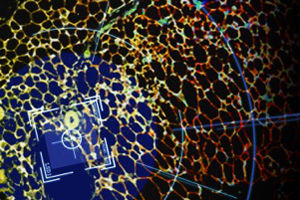Improving Control of Age-Related Obesity
Research results promise new approaches for prevention and treatment of the condition
The function and distribution of adipose tissue in the body change during the course of life. Beige fat cells, a special type of adipocytes, have the capability to use energy reserves – fatty deposits – by generating heat in a process known as thermogenesis. With increasing age, beige adipocytes take on the morphology of white adipocytes. Thermogenic activity ceases and with it the cells' ability to burn fat. As a result, the risk of obesity increases. A team working with Freiburg researchers Prof. Dr. Roland Schüle and Dr. Delphine Duteil has now proven that the epigenetic enzyme lysine specific demethylase 1 (Lsd1) plays a key role in this transformation.

Lsd1 placed on white adipocytes (red) prevents the aging of beige adipose tissue (yellow).
Delphine Duteil
The number of beige adipocytes decreases when Lsd1 levels fall in aging adipose tissue. The group nevertheless was able to maintain Lsd1 production specifically in fat cells, and thereby reducing age-related transformation of beige to white adipose tissue. In an experiment with mice, the amount of beige adipocytes in older animals was maintained at nearly the level corresponding to that of younger mice. Conversely, the research team also showed that loss of Lsd1 in younger animals led to premature transformation of the fat cells. To observe this, the researchers marked the beige adipocytes with a fluorescent protein and reproduced their transformation to white adipose tissue.
Beige fat cells can be generated using cold treatment, for example. These then use fatty acids to produce warmth. Body weight gain is limited as a result. The researchers demonstrated that Lsd1 is not only essential for the development of beige adipocytes, but also for the maintenance of beige fat cells. Therefore, an elevated Lsd1 level is indispensable for the efficient burning of calories.
The analyses showed furthermore that Lsd1 maintains beige adipocytes by means of the target gene Pparα. This gene is interesting from a therapeutic standpoint, because selective and effective drugs can activate or suppress it with relative ease. In their experiments, the team proved that pharmacological activation of Pparα is sufficient to hinder the premature loss of beige fat cells in mice with low levels of Lsd1. The animals were therefore protected from metabolic disorders that are caused by Lsd1 loss.
Original publication
Other news from the department science

Get the life science industry in your inbox
By submitting this form you agree that LUMITOS AG will send you the newsletter(s) selected above by email. Your data will not be passed on to third parties. Your data will be stored and processed in accordance with our data protection regulations. LUMITOS may contact you by email for the purpose of advertising or market and opinion surveys. You can revoke your consent at any time without giving reasons to LUMITOS AG, Ernst-Augustin-Str. 2, 12489 Berlin, Germany or by e-mail at revoke@lumitos.com with effect for the future. In addition, each email contains a link to unsubscribe from the corresponding newsletter.





















































